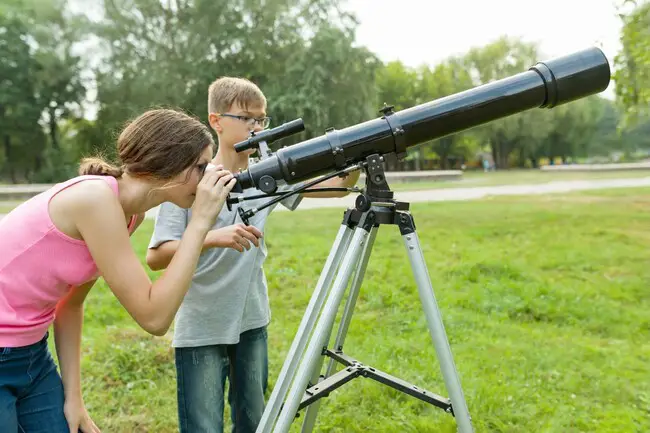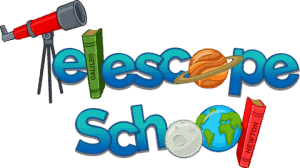Exploring the stars can be an exciting and educational activity for children under 12. Choosing the right telescope can make the experience even more engaging for young astronomers. To top it off, Let’s keep it under $200.
Finding the perfect telescope for kids can spark a lifelong interest in science and the night sky. We need more STEM students. With various options available, there’s a telescope suited for every young explorer’s needs.
If you are unsure what telescope or price range, there is an article I wrote that explains what is best by for any beginner age. Click here to check the article out.
1) Celestron 21024 FirstScope
The Celestron 21024 FirstScope is an excellent choice for young stargazers. Designed specifically for beginners, this lightweight and compact telescope makes it easy for children to explore the night sky.
They can effortlessly move the telescope around, thanks to its simple tabletop design. Setting it up only requires a few minutes, making it perfect for spontaneous sky-watching sessions. Set it on a picnic table and the whole family can enjoy.
It features a 76mm reflector optical tube, which provides clear views of the moon, planets, and even some bright deep-sky objects. The smooth altazimuth mount allows for easy tracking of celestial objects.
Additionally, the telescope’s base is decorated with the names of famous astronomers, adding an educational touch. This encourages kids to learn more about the history of astronomy while they observe the stars.
Parents will appreciate the affordability of the Celestron 21024 FirstScope. Its durable construction ensures it can withstand enthusiastic handling by young children. This telescope makes a fun and educational gift for any budding astronomer.
2) Orion StarBlast II 4.5
The Orion StarBlast II 4.5 is a fantastic telescope for young stargazers. This telescope is compact and portable, making it easy for kids to handle.
With a 4.5-inch aperture, it provides clear and bright views of the moon, planets, and even some deep-sky objects. The sturdy EQ mount is intuitive, which helps children learn the basics of tracking celestial objects.
It comes with two eyepieces that allow for different magnifications. The included 25mm and 10mm Sirius Plössl eyepieces help beginners start exploring right away.
This telescope also has an adjustable tripod, making it suitable for kids of different heights. The setup is straightforward, so young astronomers can quickly get started on their space adventures.
3) Emarth Portable Telescope
The Emarth Portable Telescope serves as a fantastic option for children under 12 and on a budget. This telescope comes with a compact design, making it easy for kids to handle and carry around. Its lightweight frame ensures that young astronomers won’t struggle to set it up or move it from one place to another.
I do believe this is more for an age of 6 to 10. Price at writing was under $60, so it makes a great see if they stay interested before spending more on a better quality scope. It is a refractor telescope and easy to setup. That is why I recommend for as young as 6 years old.
Learn more about what a refractor telescope is, click here.
It is equipped with a 360mm focal length and 70mm aperture, the Emarth Portable Telescope allows for clear viewing of celestial objects. Kids can enjoy watching the Moon, and on clear nights the planets, and even some brighter deep-sky objects. The telescope includes two eyepieces, providing different magnification options to explore various details of the night sky.
Another feature of the Emarth Portable Telescope is its adjustable tripod. This makes it more convenient for kids to find a comfortable viewing angle. The tripod is sturdy yet easy to adjust, offering stability during observation sessions. This adaptability helps young users have a more enjoyable stargazing experience.
The Emarth Portable Telescope is designed to be user-friendly. The setup process is straightforward, requiring no tools. This makes it an excellent choice for beginners who are just starting to discover the wonders of astronomy.
Pretty much only available on Amazon. Check out the current price of the scope here.
4) Celestron PowerSeeker 80 AZS
The Celestron Power Seeker 80mm is a great starter telescope for kids under 12. It offers an 80mm aperture which provides clear views of the moon, planets, and some deep-sky objects. Further it is a refractor telescope making it easy to set up for younger astronomers.
The telescope comes with two eyepieces, and a 3X Barlow providing different magnification levels for various observations. Kids can switch between 25mm for wide views and 9mm for high magnification. Further, it has a bonus astronomy software as well!
It features an altazimuth mount, making it simple for young astronomers to move the telescope up, down, left, and right. To learn more on Alt-Azimuth mounts click here.
This 80mm is also lightweight and portable. It’s easy to assemble and take on family trips, encouraging kids to explore the night sky wherever they go.
Overall, the Celestron PowerSeeker 80mm brings the wonders of astronomy to kids in a user-friendly package. It is an excellent tool for sparking curiosity and a love for space in young minds. Click Here, See where you can get it
5) Gskyer AZ70400 Telescope
The Gskyer AZ70400 Telescope offers a great introduction to stargazing for kids under 12. It has a 70mm aperture and a 400mm focal length, providing clear views of the moon, planets, and some star clusters.
This telescope is user-friendly with a simple setup process. Kids can easily adjust the alt-azimuth mount to find celestial objects. The quality glass optics ensure bright and crisp images, making it a joy to explore the night sky.
Included in the package are two eyepieces, a 3x Barlow lens, and a carrying case, making it portable and easy to transport. The Gskyer AZ70400 is typically only at Amazon Check it out on there to see it it is a practical choice for your young astronomer eager to start their space adventure.
Sky Watching Device the Whole family Can Enjoy
That’s right, what could be easy, maybe even easier than a a refractor telescope on an alt-azimuth mount? Well, Astronomy binoculars!
Bonus) Celestron – SkyMaster Giant 15×70 Binoculars
These binoculars are super easy to use, with simple focal adjustments and you can get a tripod adapter and tripod to make it easy to stabilize them for long viewing sessions or on extreme zooms.
What’s wallet friendly is that they’re under $100, so they’re pretty affordable. They’re great for the whole family, whether you’re into stargazing or birdwatching. Most people know how to use binoculars instinctively, so no setup knowledge needed.
The tripod adapter is a nice touch because it gives you a steady, comfortable view, which really makes a difference. The views are crisp and sharp, and they’re built to be durable and water-resistant.
Just don’t drop them or leave the covers off and they are always ready to go! See where you can get them
Benefits of Astronomical Observation for Kids
Astronomical observation offers children opportunities to develop skills in science and technology while fostering a sense of wonder and creativity about the cosmos.
Boosting STEM Skills
Engaging in astronomical observation helps children improve their skills in Science, Technology, Engineering, and Mathematics (STEM).

Observing stars and planets requires critical thinking and problem-solving. They learn to use telescopes and other tools, which enhances their technical abilities. Understanding celestial movements and phenomena encourages mathematical skills as they learn to measure angles and distances.
Astronomy also introduces kids to scientific concepts such as gravity, light, and planetary systems. These experiences make abstract ideas more concrete, aiding their grasp of science and math concepts taught in school.
Group activities like star-gazing nights can foster teamwork and communication, key elements in STEM education.
Encouraging Curiosity and Imagination
Astronomy sparks curiosity in children about the universe. Gazing at stars and planets allows kids to imagine distant worlds and possibilities beyond Earth.
This curiosity drives them to ask questions and seek answers. They learn to conduct research, analyze data, and develop hypotheses. This investigative spirit nurtures an enduring interest in learning and discovery.
Imagination is also stimulated, as kids envision what life might be like on other planets or storylines about space adventures. Creative thinking is expanded as they blend science with fantasy, leading to a more holistic development.
Choosing the Right Telescope for Children
When selecting a telescope for children, two key aspects to consider are ease of use and safety. These factors ensure a positive and enjoyable stargazing experience.
Ease of Use
A telescope for children should be simple to set up and operate. Refractor telescopes are often a good choice as they have a straightforward design and require less maintenance compared to reflectors.
Portability is another important feature. Telescopes that are lightweight and easy to carry will allow children to take them to various locations, enhancing their learning experience.
Adjustable stands can help kids comfortably use the telescope at different heights. Models with intuitive controls also ensure that children can quickly learn how to navigate the night sky.
Read this article on what the easiest telescope to set up and use is, by clicking here.
Safety Considerations
Safety should never be overlooked when choosing a telescope. Ensuring the telescope is built with durable materials can prevent damage from accidental drops and mishandling.
It’s important to supervise children when they use the telescope to ensure proper handling. Telescopes with non-toxic coatings and materials that do not have sharp edges minimize potential hazards.
Additionally, some models come with features like solar filters that protect children’s eyes when viewing the sun. Always review the manufacturer’s guidelines and safety instructions to maintain a safe stargazing environment.
Tips for Fun and Educational Stargazing Sessions
Creating an engaging stargazing experience for kids involves careful preparation and introducing them to basic astronomy concepts. It makes the night sky not just a spectacle, but also a learning adventure.
Planning Your Observation Night
A successful stargazing session begins with choosing the right night. Check the weather forecast to ensure clear skies. Avoid nights with a full moon, as its brightness can obscure many stars and planets.
Location is crucial. Find a spot away from city lights to minimize light pollution. Parks or open fields work well. Bring a blanket or chairs for comfortable viewing and be sure to dress warmly.
Snacks and drinks make the experience enjoyable. Pack some hot cocoa or snacks to keep the kids happy and engaged. Remember to bring a flashlight with a red filter to avoid disrupting night vision.
Plan to observe specific constellations, planets, or events. Use star maps or astronomy apps to help guide the session. Having a focused plan keeps kids interested and provides structure.
Introducing Basic Astronomy Concepts
Start simple. Begin by explaining the difference between stars and planets. Stars twinkle; planets do not. Teach them about the North Star and how it has been used for navigation.
Introduce constellations. Share stories or myths related to the constellations. This makes them memorable and adds a storytelling element to the session.
Use a telescope or binoculars to enhance the experience. Show them the craters on the moon, the rings of Saturn, or Jupiter’s moons.
Encourage questions. Kids are naturally curious, so prompt their curiosity by asking them what they see and think about the night sky.
Make it interactive. Use apps that identify stars and planets in real time. Interactive tools can transform a passive activity into an engaging learning session.


